Et Sans Résultat – Napoleonics at a grand scale
By Tom Gall
The Napoleonic era is a wonderful period to war-game, that covers roughly 1803-1815. As Napoleon rose to power in France after the chaotic revolution he stabilized the country, established a powerful army, and in many ways alarmed the noble houses of Europe. French Liberty? Not here! The era is defined by a series of coalitions generally pitting the United Kingdom and her allies vs the French and theirs that culminated at the Battle of Waterloo in 1815 with Napoleon’s final defeat.
The tactics of the times would set the way battles would be fought all the way through the US Civil War. US General Winfield Scott, for instance, would largely copy the French field manuals for the US army to use. Grand tactical maneuvers and heroic deeds would win the day and let’s not forget the pretty uniforms.
New to the period? Need some inspiration? May I suggest . Start with Sharpe’s Rifles. Sean Bean also starred in the televised adaptation which can be found online as part of .
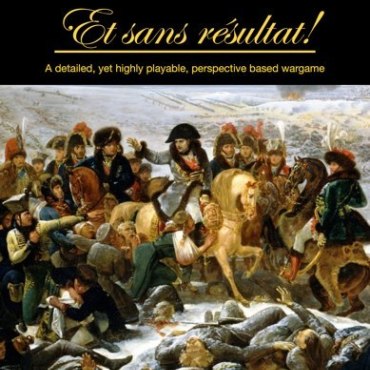 Et Sans Résultat
Et Sans Résultat
When I look for a game set in history, one of the important characteristics I look for is will I as a player be rewarded for utilizing period tactics. by the Wargaming Company is I find one such ruleset and as I play it more, I find it continues to draw me in with interesting battles, tactical challenges and importantly great fun on the tabletop.
Et Sans Résultat which for those that know French might be puzzled by the name and for those that don’t I’ll translate, “And without result.” This is a snipped from a quote by Marshal Ney who while surveying the fields of Eylau had seen all the destruction and loss of life, exclaiming that nothing had been accomplished. With Et Sans Résultat you’ll definitely accomplish many a fun game and importantly get to a result.
If you go back a few decades when war games tended to be more historical simulations that would lumber along, our gaming group would often find that we’d have to devote several Saturdays to reach a conclusion. The battles were epic, they were fun, but getting to that result in an afternoon or evening was very difficult, with Et Sans Résultat, you can run a very satisfying grand tactical game in the course of an afternoon.
ESR as I’ll call it from now on, the setting is at a grand scale. You’re running a formation one or more corps per side, each with several divisions which are made up of several battalions. A single stand in the game is a battalion. The game doesn’t concern itself with what formation the battalion is in (meaning line, or skirmish order, or attack column and so on), rather it trusts that the colonel at that level is doing or attempting to do that right thing and as battle is enjoined the dice will determine how effective they were.
The scale is one where you choose (scale agnostic). Want to play with your existing 15mm holdings? Go ahead! If you’re in the market for 10mm figures, I suggest , they’re awesome. Like the look and size of 28mm? You can do that too.
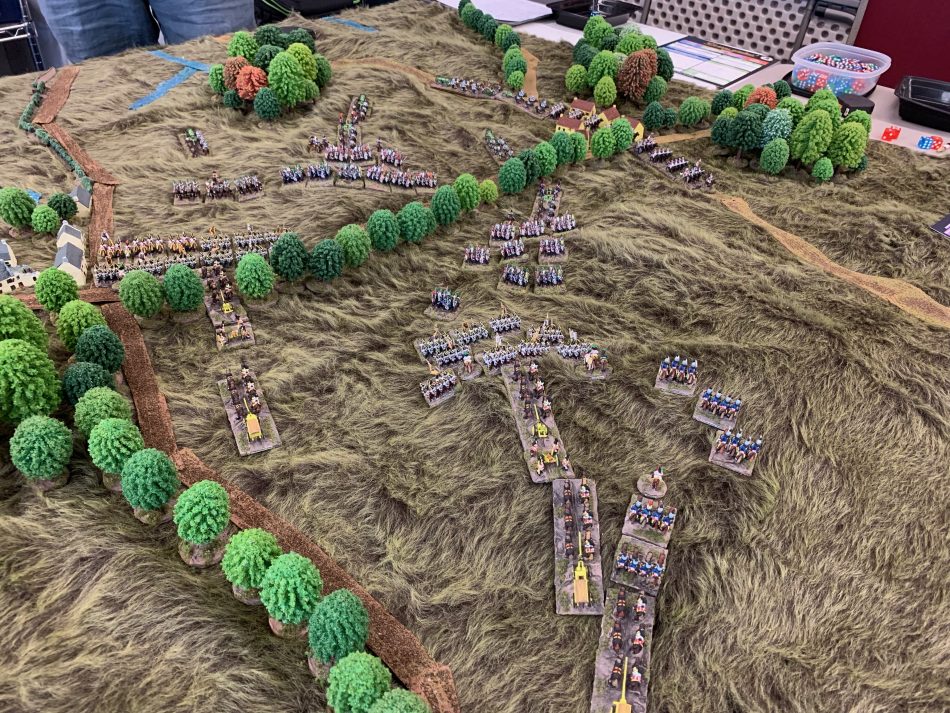
Pictured above are three Austrian divisions taking on three French divisions. The Austrians are on the bottom part of the picture, with the first division just on the other side of the trees, the second division just starting to march down the hill in line of battle and the third division just starting to form line of battle. This was played in 10mm scale and on a 5’x7′ space that modeled roughly a couple miles by a couple of miles.
Units in ESR
As mentioned the smallest unit in ESR is a battalion. You’ll have anywhere from say three to 10 battalions in a division. Within the division, you might have some artillery (just a stand or two) and then potentially a squadron of cavalry tho more often the cavalry would be off in its own division.
Each division has a set of figures that represents the “gear” which represents the area that the unit would really to or the area where undeployed units might be. Each division also has a single figure that represents the commander. Leader casualties can happen in this game and command definitely matters!
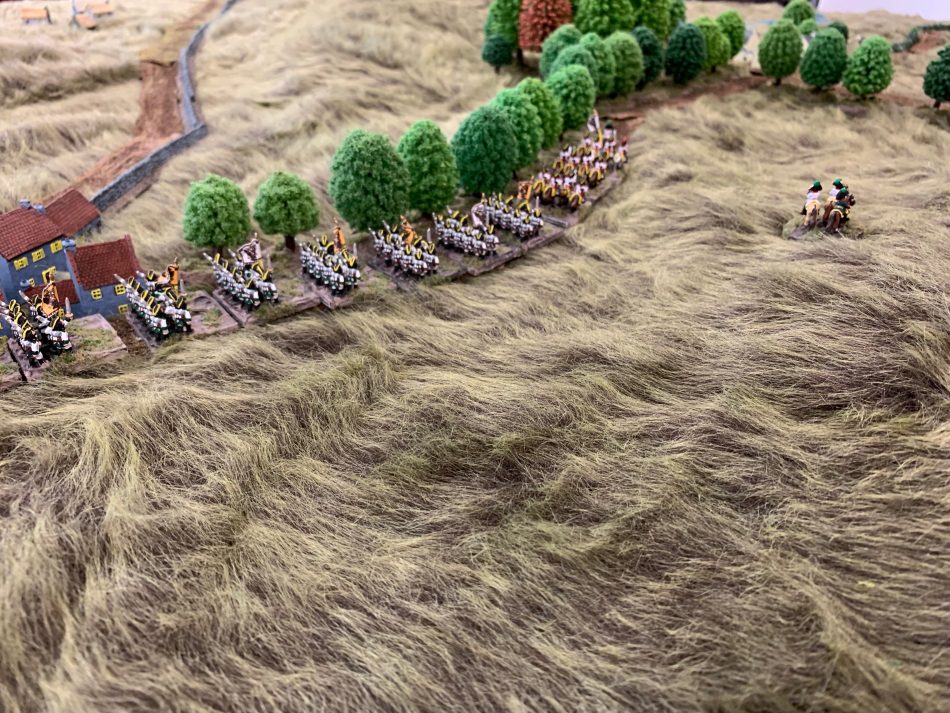
Here is a division of Austrians marching down the road. The corps commander can be seen up on top of the hill keeping an eye on the situation.
In ESR, your units, as they come onto the table, will be marching down the road in a long column, heading towards a particular destination that you have set as part of your written orders. As the enemy comes into view, you’ll need to think in terms of where you want to fight the enemy and how best to deploy your army. If you can get to a point faster, be deployed quicker, catch the enemy before they are ready, that’ll work to your advantage.
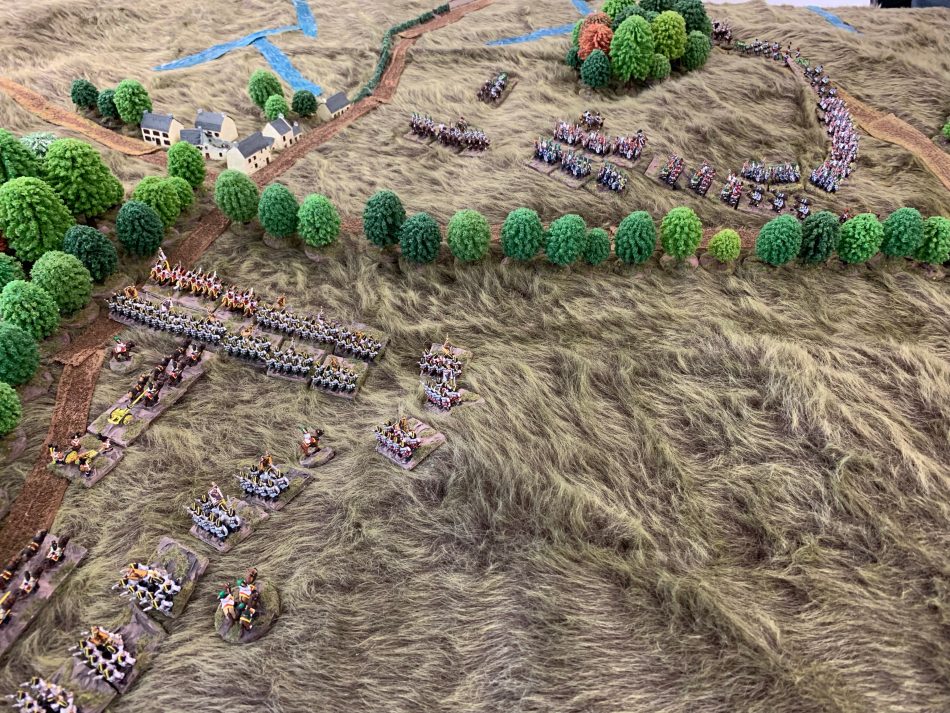
On the left, in this picture, you can see an Austrian division with all the infantry deployed, but the artillery is not yet deployed. You can also see the commander of the division on the left side and just behind the line of battle. Behind the artillery just partially in the picture is the baggage train which represents the “rear” of the unit.
Coming up the hill is another division. The division commander is at the lead of the column of ployed infantry. Meaning they aren’t deployed and are still in march column. March column is when they are most vulnerable. You can see on the hill 3 battalions from that division are deployed and moving into their battle line, getting ready to meet the French who are on the opposite side of the woods and likewise marching up and quickly forming their own line of battle.
The Turn
In ESR, the turn is broken up into several phases: the command, movement, artillery and skirmish, and combat phases. Each has their own substeps however nothing is so complicated that the quick reference sheets don’t cover what you need.
- Command: In this stage, your Corp commander is sending out orders to the various divisions. The previous orders that have been issued are checked to see if they are received (remember there are no radios in this era, pen, paper, and a courier had to inform the subordinates what to do if the plan was to be adjusted mid-battle) and leader actions such as rallying fleeing men.
Orders in ESR are Attack, Defend, Support, Move, and Reserve. The idea is that units will generally move to an area and then go on defend. If there is an enemy in the way, you go on the attack or perhaps you see an opportunity then you might adjust where you are moving to an attack in that direction.
So during the course of a game, you might move towards Potsdorf, see that the enemy is coming down a flanking road, then adjust your destination to the road the enemy is one. This adjustment of where you are moving to and thus engaging the enemy requires orders to do so, either by the Corp commander or by the subordinate who sees the opportunity.
It’s a die roll and thus not automatic depending on your leader’s rating, fatigue enemy nearby and so on. A roll on 2D6 decides your fate. Get a seven or better, and you succeed, less, and your orders will be delayed. With modifiers, and decent leaders close by odds are very good you’ll succeed. Later in the day as fatigue sets in and other circumstances, changes go down.
- Movement: A division is either ployed (meaning in march column) or deployed (in line of battle). The movement rates are a function of the scale you play. There are cheat sheets that scale up / down depending on what you choose. In 10mm, infantry on road in march column will move 12″, and once deployed into line of battle move at 8″.
I’ll note that at 10mm/15mm scale, a 4×6 area for a battle is plenty of room to maneuver.
- The Artillery and Skirmish phase captures the initial build-up to the battle when skirmishers are kicked out and artillery is blazing away at range. The outcome of both actions is an assessment. Artillery fires out to 6″, (at 10mm), and skirmishers out to 3″, depending on the size of the deployed guns, the quality of the skirmishers, any fatigue and so on, will get you a set of modifiers, roll 2D6, if you can get to a score of 10 or more, then the opposite side has to perform an assessment which may result in anything from the fleeing the field to absolutely nothing.
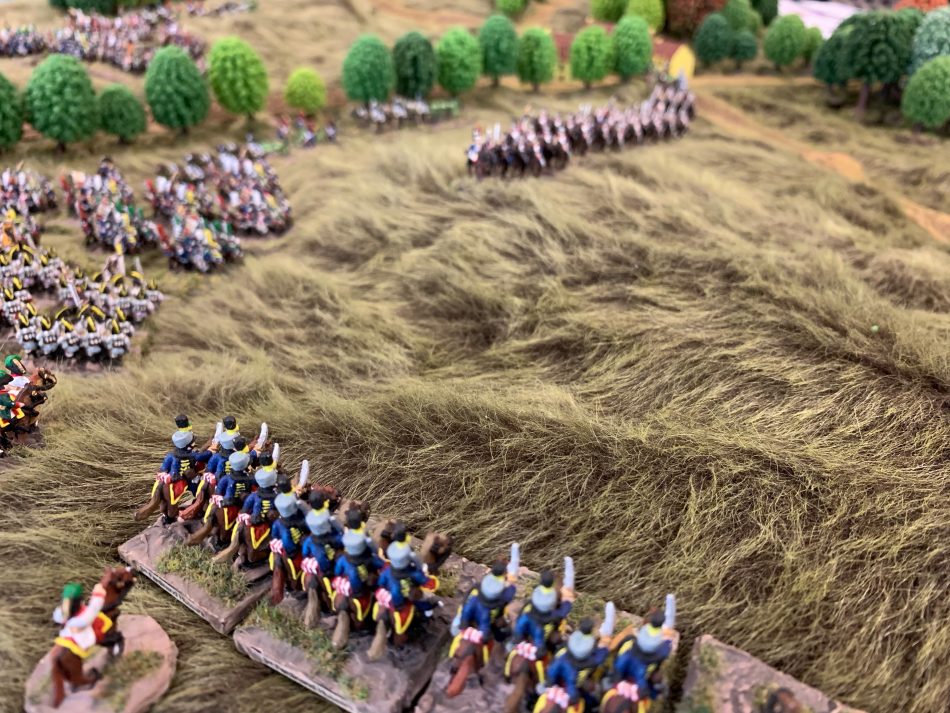
- Combat is, as you’d expect, the part of the game where the resolution of musket fire and cavalry scrums occur. At the start of and at the end of the Combat stage, you have the ability to convert orders, which gives you the mechanic to seize opportunities. Charge that hanging flank? Now’s the time! This also means that the Combat phase can be extended depending on how the outcome of the fighting goes.
Combat occurs when two stands are in contact. Remember the effective musket range was ~100 yards back in the day and at these scales, the battalion stand represents not only the formation your men are in but also their effective range.
Combat is resolved with 2D6 and some set of modifiers based on the situation you are in. Tally up your combat rating, any fatigue your division has if you are facing more than one unit, your characteristics such as if you are light infantry, rated as Shock, and so on. Your opponent likewise tallies up the same set of modifiers, you both roll 2D6, add in your respective modifiers and compare the result. Whoever has the higher number will be the winner, with the greater the difference achieving more.
In the best case, as the victor, you’ll take no fatigue and achieve a breakthrough meaning the enemy retreats and you’re able to press the attack and engage another unit. The loser at best might gain fatigue which is assigned to the division and at worst you’ll completely lose the battalion with it removed from the board.
Fatigue in the game represents loses and the men getting tired and thus operational effectiveness drops. If your fatigue value for your division equals the number of battalions you have deployed the division is going to retreat, dropping back 6″. If your fatigue is 1.5x the number of deployed units, you’ll break and move back a foot. Either way, you’ve held the line.
Quick Reference & Rulebook

The core rulebook by David Ensteness is 169 pages and is a great guide for getting to know the game. The sections are color-coded matching the quick reference sheet at the left means that going between the quick reference and the rulebook can be accomplished very easily.
The core rules are ~60 pages with chapters devoted to each phase. The Quick Reference Sheet (QRS) is color-coded as well, matching the book, which makes looking up rules super easy.
The next broad section of the rulebook is about the various armies, with 80 pages devoted to ratings, states and so on you’ll have what you need to start to field a force.
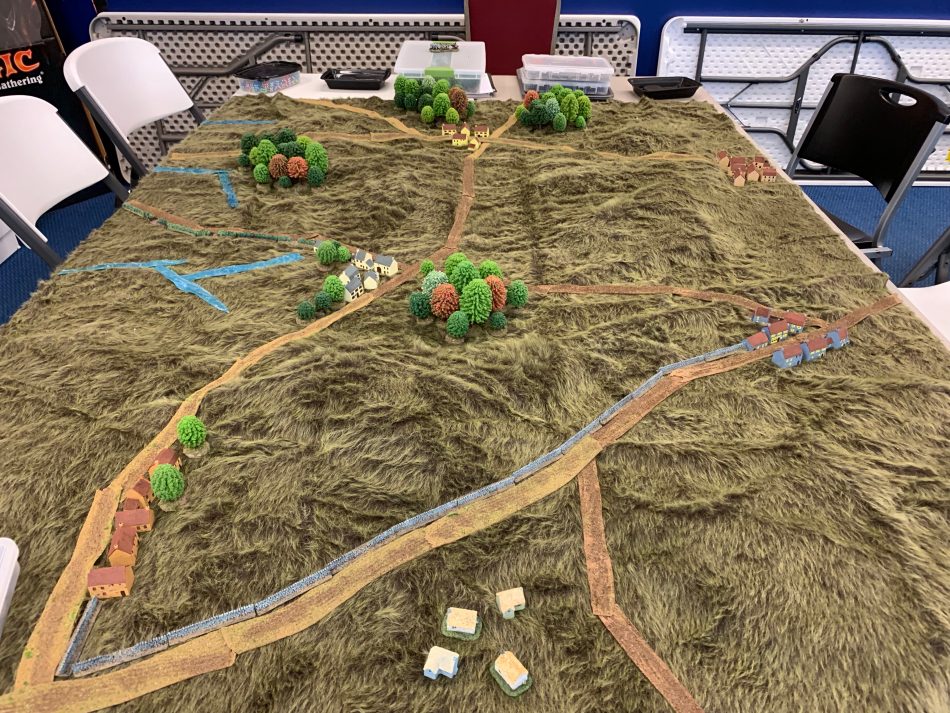
The last 12 pages have some sample scenarios to get you started and gives you a great example of how you might want to structure future games, where you produce two maps, one of each side and limit the information you give the players. As they approach the tabletop this means they’ll have to survey the area and formulate their own plans.
Imagine as you look at the map, your generals assembled for the morning briefing, the sleepy forests and villages ahead of you as the mists start to burn away, how will you march into the area knowing that the enemy is but a few miles away? How will you use the terrain to your advantage? Can you win the day?
Playing a game
I was lucky enough that David Ensteness and I were able to get together and play a game. He wrote up an which I encourage you to read. It’s a great account of what you too can experience.
Getting started
ESR is really easy to get into. You’ll need the rules, which are available for purchase from (ESR also visits many gaming conventions). Like most other miniature games, you’ll also need a tape measure, a few D6, an army, and some terrain.
In my next articles, I’ll talk about the army boxes that The Wargaming Company has for sale. They’re a great value. I’ll talk about some of the terrain options that are out there, and how to set a great looking table. I’ll also post about the many campaign books that the War Gaming company has which will help you put together a series of fun historical battles for you and your gaming group to play.
Altogether this is one of the great things about ESR, it’s not just a set of rules, there is a whole ecosystem of material that will help you get going and have a fun time.

“Largely copied?” Scott’s drill is virtually a word for word plagaism. ?
You mention being rewarded by using historic tactics and I feel that is one area ESR falls short. You make virtually no tactical decisions because of the scale. Grand tactical certainly but the core aspect requires a major paradigm shift in thinking IMHO.
Now I’ve only played the game once, with David, and it was a pleasant experience and the game accomplishes its goals quite well. I’ll also echo that it is extremely well supported. I personally would play again but I doubt I’d seek it out.
Definitely fair observation on the tactics side that needs some clarification in what I was attempting to say. For instance if you’re looking to utilize peloton/company level tactics, that’s not ESR. If you’re looking to be challenged with tactical decisions the likes of Napoleon had to be thinking about, that is ESR. David didn’t try to capture things like, can a battalion form square in time before being hit by a cavalry change. Within the die rolls when tho two units hit is the presumption that the respective Colonels are trying to do the right thing and depending on what happens with the rolls, will take into account success or failure. Better troops have the modifiers that make success more likely for them hindered by how much action they’ve seen during the day.
I think it’s a reasonable design decision.
Very nice indeed
https://www.10mm-wargaming.com/
https://www.10mm-wargaming.co.uk/
Take care
Andy